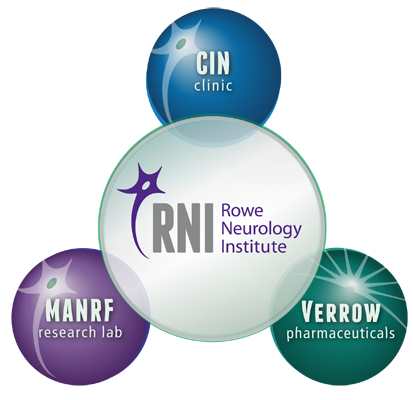
RNI is not simply a clinic.
RNI’s structure, with clinic, research lab, and commercialization engine operating side-by-side, is what allows us to bring cutting-edge techniques and technology to patients. Yet even some longtime patients are unaware of how these pieces interact.
-
Return of the Physician-Scientist
At the heart of RNI is a belief in the physician-scientist. In treating patients, doctors see firsthand what medical needs are not being met by existing drugs and best practices. New ideas can be investigated immediately at our own laboratory. When that lab research yields results that can help patients, RNI brings it directly to its patients, and to patients everywhere. We call this loop “bedside-to-bench-to-bedside,” and it is the efficiency of completing the loop in-house that makes our research so much more productive than our relatively small size would suggest.
-
MidAmerica Neuroscience Research Foundation
We cary out research in several different types of “lab.” In our physical lab, with microscopes and scientists, Dr. Rowe followed a hunch that led to the creation of a new therapy for secondary-progressive MS patients, who had no other options and no available drugs. In more than ten years, that therapy has helped hundreds of patients defy the expected prognosis for this ravaging disease, and stabilize their quality of life.
We also carry out research in the “virtual lab” of our computerized medical records. RNI studies data on its entire patient population to seek out connections between apparently-unrelated disorders. One of our most significant discoveries was the connection between migraine headaches and sleep disorders, and further research has begun to reveal the underlying mechanisms.
-
Verrow Pharmaceuticals, Inc.
It seems counterintuitive to most people, but commercialization is the only way for new scientific discoveries to reach patients. Proving the safety and efficacy (effectiveness) of new drugs, as mandated by the FDA, is extraordinarily expensive, and private capital must be involved. And that is where Verrow Pharamaceuticals, Inc., comes into the RNI picture. This small pharmaceutical start-up company is the engine of commercialization for new therapies coming out of our lab. Its participation is vital to making new therapies commercially viable: building patent protection, carrying out clinical trials, and finally raising tens of millions of dollars to get the drug from the lab to the pharmacy. Any misstep along the way can prevent even the most promising new therapy from reaching patients.
Verrow is currently developing a therapy that branched off of the MS therapy mentioned above. In seeking to make the MS treatment safer for kidneys, Dr. Rowe’s team struck upon an existing molecule which was considered until that time to have no function inside the body. The research team at MANRF showed that this compound protects kidneys from a wide range of intravenous drugs. Verrow has secured patent protection for this discovery, and is seeking partners to develop its use in MS, cardiology, and other medical areas.
Besides its small size, it is Verrow’s philosophy that sets it apart from the Big Pharma companies. Big companies “push” technology into the clinic. For them, bench-to-bedside is a one-way street, with a scientist at one end cranking out new chemical compounds. At the other are marketing and management people, asking every question except the one that really matters: Will this help patients?
RNI is based on a philosophy that research serves patient care, and patient care serves research. All of the caregivers have access to findings and ideas, and can contribute to lines of inquiry. We also participate in Clinical studies sponsored by pharmaceutical companies, who are developing new approaches to therapy.
RNI also has a sister organization, a non-profit foundation, which sponsors and conducts basic research into neurological disease areas. Visit the MidAmerica Neuroscience Research Foundation site to learn about the science, or to make a donation to its mission:









